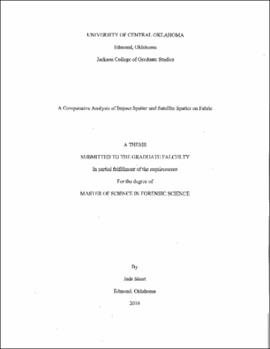| dc.contributor.advisor | Adams, Dwight | |
| dc.contributor.author | Short, Jade | |
| dc.date.accessioned | 2020-07-09T14:39:09Z | |
| dc.date.available | 2020-07-09T14:39:09Z | |
| dc.date.issued | 2016 | |
| dc.identifier.other | (AlmaMMSId)9982529169602196 | |
| dc.identifier.uri | https://hdl.handle.net/11244/325015 | |
| dc.description.abstract | Bloodstain pattern analysis (BPA) is the practice reconstructing bloodletting events by interpreting the bloodstains left at the crime scene. In addition to the examination of well-formed bloodstains on non-porous surfaces, the bloodstain analyst is often asked to analyze bloodstained clothing. These types of analyses present challenges to the analyst because of the distorted nature of bloodstains on fabric. Although the evaluation of bloodstained fabric is both difficult and common, the research concerning bloodstain development on textiles is limited. A strong understanding of bloodstain mechanisms on fabric is imperative because an analyst's conclusion may implicate or exclude the wearer as an assailant based on their interpretation. As an effort to contribute to the limited research, the current research comparatively analyzed two types of spatter, impact spatter and satellite spatter, on 100% cotton jersey knit t-shirt fabric and 100% cotton bed sheet fabric. Impact spatter was reproduced by a mousetrap apparatus and satellite spatter was simulated by dripping drops of blood into a volume stain. The two types of spatter were analyzed in a quantitative manner through the use of ImageJ. The bloodstains were qualitatively analyzed with and without macroscopic magnification. Descriptive attributes such as size, impact angle, shape, symmetrical properties, and weave saturation were recorded and a narrative analysis allowed the presentation of other unique features of each spatter. The non-fabric control samples successfully reproduced unique characteristics of impact spatter and satellite spatter and were used as a standard for the comparison of the spattered fabrics. The t-shirt fabric proved to have the highest amount of bloodstain distortion. The spatters were comparative in the quantitative and qualitative analysis; however, the narrative analysis revealed the presence of fine, very small submillimeter stains on the satellite spattered fabric that was absent in the impact spatter samples. Additionally, the satellite spattered t-shirt fabric exhibited some signs of random directionality within the bloodstains. The bed sheet fabric yielded results that coincided more with the controls in terms of size. The descriptive stain analysis yielded similar results; however, the narrative analysis revealed the same results for the satellite spattered bed sheet fabric as the satellite spattered t-shirt fabric. Furthermore, the impact spattered bed sheets revealed distinguishing spines around the stains; spines were present in the controls, but not in the t-shirt fabric. The conclusions of the current study revealed that impact spatter and satellite spatter may or may not have distinguishing characteristics depending on the type of fabric; however, the study also affirmed the previous claims that impact spatter and satellite spatter have many similar qualities. The characteristics of impact spatter on fabric have been investigated by previous research; however, because of satellite spatter's resemblance to impact spatter, more research ought to be conducted on satellite bloodstain development on an array of fabrics and also at different angles and distances from its source to its impact site. Experimentation of this nature will contribute to the knowledge of small bloodstain development on fabric and thus, assist in the advancement the discipline. | |
| dc.rights | All rights reserved by the author, who has granted UCO Chambers Library the non-exclusive right to share this material in its online repositories. Contact UCO Chambers Library's Digital Initiatives Working Group at diwg@uco.edu for the permission policy on the use, reproduction or distribution of this material. | |
| dc.subject.lcsh | Bloodstain pattern analysis | |
| dc.subject.lcsh | Cotton fabrics | |
| dc.title | A comparative analysis of impact spatter and satellite spatter on fabric. | |
| dc.type | Academic theses | |
| dc.contributor.committeeMember | Gravel, Craig | |
| dc.contributor.committeeMember | McCoy, Mark R. | |
| dc.thesis.degree | M.S., Forensic Science | |
| dc.subject.keywords | Satellite spatter | |
| dc.subject.keywords | Impact spatter | |
| dc.subject.keywords | Fabric | |
| dc.subject.keywords | Textile | |
| dc.identifier.oclc | (OCoLC)ocn982487266 | |
| uco.group | UCO - Graduate Works and Theses::UCO - Theses | |
| thesis.degree.grantor | Jackson College of Graduate Studies. | |
